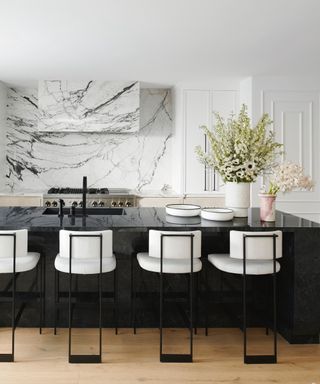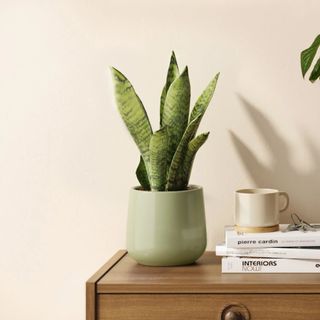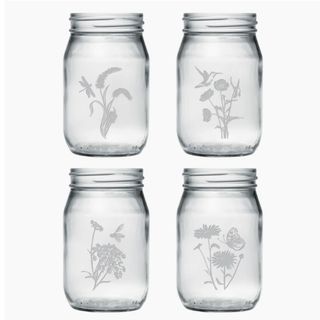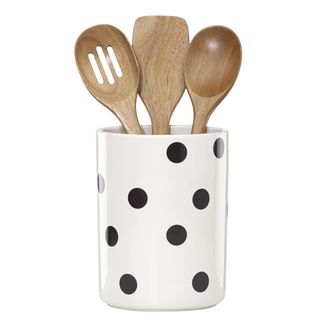Coco Gauff may be used to setting precedents on the court, but the tennis pro's home is just as inspiring, especially with its use of a classic color palette. In her Delray Beach kitchen, Gauff makes a case for that most versatile yet powerful color combination: black and white, whose timeless appeal is undeniable to designers and real estate agents alike.
Gauff's black-and-white kitchen is comprised of dark countertops and painted cabinets, contrasted with light-colored walls (which also have a small gallery wall to bring personality to the space). Like all of us, Gauff has a habit of eating pasta straight from the pan, whatever the color of her kitchen, we all do. “As an athlete, pasta is a staple in my diet because it provides me with the balanced nutrition and functional fuel I need on and off the court,” she says.
Cooking habits aside, there's a lot we can learn from Gauff's decor choices: While the color combination is classic, it's so relied upon that it can be hard to make a black-and-white kitchen feel exciting, so incorporating different textures and introducing elements (like Gauff's gallery wall and indoor plants) can go a long way.
'The kitchen is the heart of the home, so choosing the right colour scheme can really make a big difference,' comments estate agent Rachel Stringer. Raleigh Real Estate“In my years working as a real estate agent, I've seen trends come and go, but there's one style that never goes out of style: the classic black and white kitchen. There's something about this combination that's both timeless and incredibly versatile. It's the perfect blend of elegance and simplicity, making it a great option for any home.”
But as we said, this palette's versatility can make it seem bland, which is something we can learn from Gauff. First, she combines a variety of textures, most specifically black marble countertops (and the kitchen island you can see in the background of the last photo in the carousel) with dark wood cabinets. Different hardware can also help achieve different textures.
“One of our clients was hesitant to choose a black and white kitchen because she thought it might look too stark or cold. We discussed how adding different textures and materials would bring warmth and character. For example, pairing glossy white cabinets with matte black hardware and marble countertops breaks up the monotony and adds a sense of luxury,” Stringer says.
“Using natural elements, such as wooden accents and a colorful backsplash, can soften the overall look and create a cozy atmosphere.”

The kitchen is black and white with a variety of textures, similar to the technique seen in Gauff's spaces.
(Image courtesy of Ali Budd Interiors/Alex Lukey)
Accessories also make an impact: in her final slide, Gauff made the ultimate statement with a contemporary red, gold and black chandelier, and Stringer noticed.
“I can't stress enough how important lighting is in a black-and-white kitchen. Good lighting enhances contrast and makes the space feel more inviting,” she says. In addition to chandeliers, she also recommends under-cabinet lighting to highlight countertops. “These little touches make a big difference and elevate the overall look,” she says.
“Plus, a black-and-white kitchen offers endless possibilities for personalization. By changing out accessories like rugs, towels and even small appliances, you can keep the space fresh and updated without committing to a full-on renovation. It's like having a little black dress in your wardrobe; you can dress it up or down depending on the occasion.”
A Gauff-esque starting point, these accessories will add a sense of interest to any kitchen of any color scheme.

Automatic watering sansevieria


Kate Spade New York Cookware Set

(Image courtesy of Elizabeth Krueger Design)
Designer Lois Riley of Mowlem & Co. agrees. While it's unclear exactly how large Gauff's space is, Riley adds that palettes work well in small kitchens, reiterating the importance of a variety of textures and accessories.
“A black and white palette works so well in the kitchen – it has timeless appeal and gives a chic, contrasty definition. It's great for small spaces, as it doesn't overwhelm with one colour or tone and can be softened by adding wood finishes on the floor and other furniture and accessories,” she comments.
“If you're going to use color in blocks, it's best to base your scheme on the black pieces at the bottom and the white pieces on top.” I employ this trick no matter the size of the space I'm working with.


